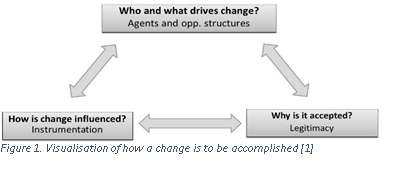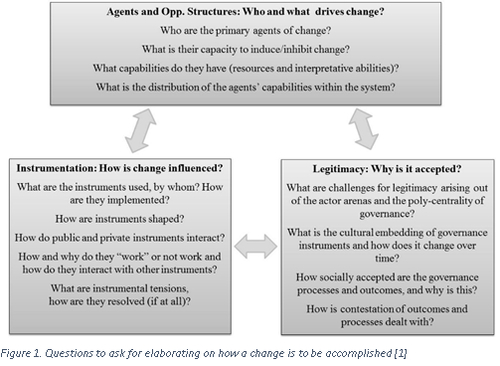1.1 Literature study
In today’s society, technology plays a very large role and they have become increasingly intertwined. This is not just a one-way structure in which this happens, where technology influences society, but this goes both ways. The way a technology is implemented and or perceived is of course very much dependent on society itself and all the players that are active in this field. This structure where technology is not an individually acting power, but embedded in society, is called a socio-technical system and innovation system. If one wants to change society with technology it is therefore crucial to understand how the governance of such a change is to take place. One should know what elements form these socio-technical systems, taking into account sociocultural and economic aspects. Only then a good transition into a society that has adopted the new technology can exist.
An example that shows that technology is not acting in isolation in society is that wind turbines are not yet so largely employed that it can compete with existing fossil fuel energy sources, because people do not want them in their backyards and they can interfere with migratory bird routes. Same holds for electric cars, the technology is there, the knowledge is widely spread that it would help reduce carbon emissions, why is it not widely used yet? Because it requires many adaptations to society, large investments and certain parties do not want this change to happen or to happen too quickly.
Socio-Technical & Innovation (ST&I) systems are very complex due to all the actors of different scales, individual ones and organisational ones (non-profit and commercial). Also, the technology has to be produced, adopted, and become widely used. In order to make this possible, the infrastructure for all this should be present as well. Something that makes the problem complicated as well is the following. The way in which technology and innovation will advance is hard to predict. Combining this with an ever-changing preference and interpretation of society, makes existing technologies already unstable, but especially ones still under development.
The latter complicating factor becomes increasingly important when the technology is to change the daily life of people. All these people and all the different organisations will have different opinion about the technology due to for instance, difference previous experiences, expectations and just different preferences and needs. These needs will be different per individual and organisation depending on their respective benefits, costs which can lead to pushing in different directions and sometimes even in resistance. Two more personal factors that should not be underestimated are the cultural heritage of certain societies or groups, these can sometimes conflict very much with rational reasoning and the acceptance of change. Next to this it should also be taken into account that if the individuals or groups do not intrinsically believe in sustainability itself, so without an economic incentive, they will most likely not want to contribute to the transition.
As mentioned before, a good transition of the society is needed for a new technology to be well embedded, especially for a sustainable technology. A transition where there is “a coevolution of economic, cultural, technological, ecological, and institutional developments.”[2]
Something that could help the transition is starting in a niche, trying to get success here and then scaling it up. Starting small can for instance help by overcoming the early hurdles at a small size and using the successes to convince the broader public. In history, most of the changes have started in a niche before being accepted by society as a whole and therefore were crucial for the transition.
When looking at the larger picture of transition, so beyond the niche-part, a so-called S-curve can be described. This start with the beginning of the niche-part where a start is being made with the development of the niche, so this doesn’t at all yet influence society. Then when the niche starts to be succesfull, it becomes more influential and starts to be noted by society. If this starts and the technology is shaped such it can be accepted by society it will accelerate and be implemented in society on a large-scale. Finally, when the technology is embedded in society it needs to stabilize and society will have found a new equilibrium.
The stages before the acceleration are crucial. If these are not structured and well-prepared, the acceleration process has a high chance of failure. Therefore the following have to be incorporated. Expectations and visions need to be described well, they provide guidance during development, but can definitely be subject to change during the process. They are also important to external actors to get an idea of your niche/technology. Secondly, social networks and the involvement of actors will help to create widespread support and acceptance. Thirdly, the more tangible preparations need to be defined such as: “technical design, market demand and user preferences, infrastructure requirements, organizational issues and business models, policy instruments and symbolic meanings.”[2]
Summarising, if a change is to be realised in a socio-technological system, not only the technology and the infrastructure for this need to be created, but also the ones that will be influenced and will or will not to be willing to adopt it have to be taken into account and need to be willing to change their behaviour (this is the case for individuals as well as organisations). Because of the uncertainty in the change, the ride will rarely be a smooth one and encounter many obstacles. In order to correctly reach everyone it is important to know all the instruments that are needed to establish the change. Starting in a niche can very much help with this, but then it is important to prepare very well for the moment that this niche will want to expand to the widespread society, is the technology to be embedded fully.
Chapter 1.1 Literature Study





